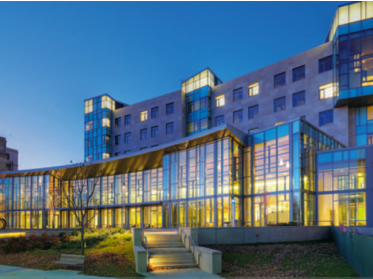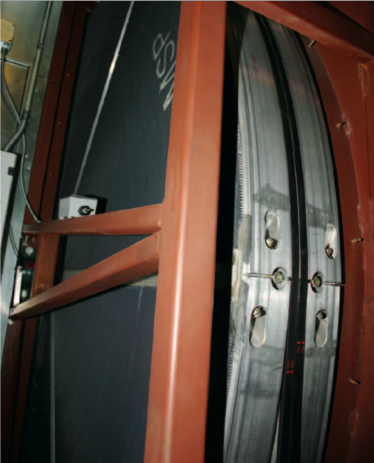
Like any ambitious construction project, the new MIT Sloan School of Management building has a story to tell—one that does not primarily revolve around architecture or technology, in spite of a striking façade and state-of-the-art classrooms. Instead, the story of E62, featuring the Joan and William A. Porter 1967 Center for Management Education, involves a decade-plus effort to design an building with the highest energy performance standards possible.
Integrated, not decorated
“We tried hard, and I think succeeded, to get a building where the sustainability is baked in,” says Walter E. Henry, director of the Systems Engineering Group in the Department of Facilities. “It isn’t the frosting but a fundamental part of how we designed the building.”
John Sterman, Jay W. Forrester Professor of Management, recalls an old Sloan building where rusted windows admitted frigid gusts in winter and keenly appreciates “a very pleasant new place to work and teach.” He proudly notes E62’s tight building envelope with its triple-insulated windows, carbon-dioxide sensors triggering fresh air flow, and secure underground bike parking to encourage cycling to school. Cindy Hill, MIT Sloan School director of Sloan Capital Projects, particularly likes the first-floor gallery of the Porter Center with its terrazzo floor, which uses green and brown crushed glass from recycled beer bottles.
The new building does not support the conspicuous “whiz-bang” technology that some MIT visitors seem to expect. Sterman notes, “Our first priority was the highest building insulation you can achieve.” Henry adds that the building’s sustainable elements were designed “to be more felt than seen.” That does not mean innovation was lacking. In fact, in 1997, when MIT Sloan first took up the idea of creating a central home for its far-flung faculty, recalls Sterman, “we pushed to make the building as green as it could possibly be.” These green advocates were able to demonstrate that sustainable features were both best for the building and its occupants—and a sound investment.

The new building offers inviting public spaces where people can meet and work. Use of advanced lighting and shade controls maximizes natural daylight and controls heating from the sun—measures that serve to increase both comfort and energy efficiency. Photo: Melody Craven, MIT
Passion, persuasion, and process
Meeting this challenge required years of collaboration, persistence, and “passion,” according to Hill, an effort sustained through tough fiscal times that hindered fundraising, and through two MIT administrations. There were countless meetings an, not surprisingly, continual reviews of facts and numbers.
One strategic decision made early in the evolution of the new building proved critical to this lon and successful effort: the adoption of an integrated design process (IDP). In this approach to construction, all the stakeholders must coordinate their ideas from the very beginning, agreeing on a set of goals and establishing a production scheme for achieving them. The IDP means a slower startup for a building project, but because the give-and-take among players occurs at the earliest stages, costly mistakes can be avoided later in construction. Guided by Marc Rosenbaum of Energysmiths, an MIT group including Sterman, Hill and Henry, and the architects, lighting designers, and engineers began meeting early on to map out aggressive energy performance goals for E62.
Rosenbaum says that together they “looked at what was possible” for E62 and figured out ways to achieve what were for MIT unprecedented efficiency targets in cooling, heating, lighting, and ventilation—always utilizing the most precise performance metrics. MIT had selected architecture firms (Moore Ruble Yudell and Bruner/Cott) and engineers (van Zelm Engineers) with demonstrated interest and experience in energy performance so there was an unusual degree of cooperation during the IDP, according to Henry.
Hill, who admits “I didn’t know much about green then,” shuttled back and forth between the IDP team and school officials, describing such innovative technology as chilled beams for heating and cooling, a heat wheel for energy recovery, and automated window shades. She had to “research, get information, make presentations,” and even then, sometimes, “everybody made a leap of faith.” Says Sterman, “We had to persuade people that building green was something important, that it would benefit people working in the building and Institute, not just save energy and reduce greenhouse gas emissions.”
But does it cost more?
From the outset, there as concern that integrating green performance into Sloan’s new home might add substantially to the project expense. “Are we getting the right thing for this kind of money?” Hill recalls sensing from administrators. Sterman gives former Sloan Dean Richard Schmalensee, the Howard W. Johnson Professor of Economics and Management, credit for “stepping up and saying, ‘We’re going to do it anyway.'” In the end, in large part because of the thorough design process, the team found that high energy performance features would not mean additional expense and might in fact save MIT money. when you do the detailed analysis and thinking up front, says Rosenbaum, “there will be fewer mistakes and costly changes later in the process.” The IDP actually “let us find better and cheaper solutions,” Sterman says. “A lot of people were skeptical,” he says, but “our building came in on time and on budget.”
“These things take a long time, and we’re the beneficiaries of the fact that they were out there, working together to identify ways to have the highest energy performing building,” says Theresa M. Stone, who served as executive vice president and treasurer during the project. Although Stone arrived after the planning process, she firmly grasped the “level of focus, conviction, and insistence of all the interested parties—the people executing and those who would be consumers. It was an impressive collaborative process.”

This “enthalpy wheel”—located in building E62—preconditions incoming air so as to reduce the need for heating and air conditioning. The wheel salvages useful energy from used building air and transfers it to incoming fresh air, warming and humidifying it in the winter and cooling and drying it in the summer. Photo: Melody Craven, MIT
Green dividends
After a partial year of occupancy, ongoing studies are validating predictions that going green also makes good business sense. “The numbers so far show great energy savings,” says Henry. Building energy modeling studies compared the as-designed building to the same building designed to meet only current construction codes. The E62 design came out consuming 43% less energy. In operation, the building has met or exceeded the goals MIT set for the architect and engineers for peak loads: for every square foot of floor area, it uses 0.75 watts for lighting and 10 Btu per hour for heating, and for every 1,000 square feet, 1 ton of cooling. Those numbers are all about half of typical building design values.
E62 “embodies all the things MIT wants in a building,” sums up Stone. It demonstrates “the kind of thinking and research MIT stands for” around energy issues, and that it is possible to design “beautiful and functional” facilities that save on energy costs and contribute to the long-term financial stability of the institution. The building recently was awarded a Gold-level certification by the US Green Building Council’s Leadership in Energy and Environmental Design (LEED) program.
Sloan’s new building has already begun to make its mark on current and upcoming campus construction. A sister Sloan building is under renovation, applying some of the same energy efficiency measures used in E62, and the recently completed Koch Institute for Integrative Cancer Research incorporates key laboratory energy conservation ideas. Beyond specific building techniques, E62 has important lessons for MIT. The Institute is now committed to using the integrated design process in its new projects, and emphasizing energy performance. Stone says, “This building demonstrates that it is not a good idea to design a beautiful building and then think about energy features, but that the thinking has to be integral from the outset.” Sterman adds even more forcefully, “There is no reason to build a building in a traditional way. It’s a sign of haste or laziness.” Concludes Henry, “If we can show that the building works well and that the incremental cost was small or none, then we will have more support to follow the process for future buildings….We will never do better and make advances if we do what everyone has done before.
This article appears in the Autumn 2011 issue of Energy Futures.